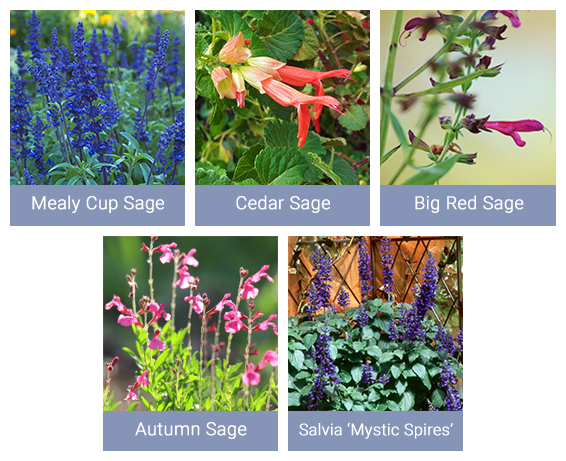Drought-tolerant and deer-resistant, salvia is a savvy replacement for water-guzzling grass. Feast your eyes on a few of our favorites.
If you haven’t checked out SAWS’ WaterSaver Landscaper Coupon list, you may want to peruse it for a bit. More than 100 water-saving plants are included. This article will explore one of the largest species groupings, and one of our personal favorites: Salvia, a.k.a. sage.
The name “sage” is often used for kitchen and medicinal salvias, while “salvia” gets used for the ornamental ones, but they’re all very closely related. Salvias can be distinguished by their unique square stems, tiny hairs that prevent water loss, and small flowers that grow in upward spires.
Dozens can be grown in Central Texas, and once established, little maintenance or water is required. They can be cut back once or twice a year to keep a tidy shape. Many prefer full sun, but others do well in part shade, so there’s a salvia for every occasion. Bonus: deer don’t relish the texture, aroma or flavor of salvias.
Here are a few of my favorites to include on your shopping list for the coupon season.

Mealy Cup Sage
Despite the name, there’s nothing mealy about this plant! Even within this species there are multiple cultivars available: ‘Henry Duelberg’, ‘Augusta Duelberg’, ‘Victoria’ and ‘Evolution’ to name a few. It’s one of Texas’ most widely exported perennial flowers. You can expect plenty of summer butterflies and moths with any of these salvias.
Cedar Sage
If you want hummingbirds, put in cedar sage with some Turk’s cap or red yucca then sit back to enjoy the show. The large, tube-shaped flowers and fiery red color are absolute magnets for the buzzy birds. Cedar sage has the added benefit of being a Texas native so our local hummingbirds are familiar with it and love it. Like all the other plants on this list, its drought-tolerant nature will go easy on your water bill, too.
Big Red Sage
Big red sage is also a hummingbird magnet, but unlike cedar sage, it tends to sprawl out more. This plant is endemic to the Texas Hill Country and once thought to be extinct, but the landscape industry has brought it back from the brink.
Autumn Sage
It may be small, but autumn sage is a workhorse in the water-saver garden. It can be a showstopper in full bloom, with warm colors ranging from pink to red to purple and white. (There’s enough commercial cultivars available to fill an entire landscape with resilient variety.) But even in repose, it’s sturdy, upright and nearly evergreen, providing easy structure to mixed borders and endcaps.
Salvia ‘Mystic Spires’
This was the first plant I received from a coworker — it was also one of the first ornamental plants I ever tried to grow. I planted my tiny mystic spires salvia in a medium-sized pot with some purple skullcap and it took off! This plant is easy to grow and gives obvious signs when it needs water, but it’s difficult to kill.
Our plant database has information on nearly two dozen salvia species, but there are always more species and cultivars appearing in nurseries. If you see a salvia you like in a park or someone’s yard, take a picture and ask your favorite nursery if they carry it.
And if you’re a newly-turned salvia fan, consider the WaterSaver Landscape Coupon to replace some water-guzzling turf with a collection of your favorite salvia species.


